Article
A yard storage strategy for minimizing traffic congestion in a marine container transshipment hub
This paper studies a storage yard management problem in a transshipment hub where the loading and unloading activities are both heavy and concentrated. In order to reduce the number of reshuffles, which helps to reduce the vessel turnaround time, the port operator uses the consignment strategy to group export and transshipment containers according to their destination vessel. To reduce the potential traffic congestion of prime movers, a high–low workload balancing protocol is used. A mixed integer programming model is formulated to determine the storage locations of incoming containers, the number of incoming containers and the smallest number of yard cranes to deploy in each shift. An iterative improvement method is developed to solve the problem, in which a tabu search based heuristic algorithm is used to generate an initial yard template, and then the generated yard template is improved by an improvement algorithm iteratively until an optimal or a satisfactory solution is obtained. Experiment results show that the proposed method can generate excellent results within a reasonable time, even for the extreme cases.
Ketersediaan
Informasi Detail
- Judul Seri
-
A yard storage strategy for minimizing traffic congestion in a marine container transshipment hub
- No. Panggil
-
ATC LO HAN a
- Penerbit
- Singapore : Springer., 2008
- Deskripsi Fisik
-
24p
- Bahasa
-
English
- ISBN/ISSN
-
-
- Klasifikasi
-
LO
- Tipe Isi
-
-
- Tipe Media
-
-
- Tipe Pembawa
-
online resource
- Edisi
-
16 February 2008
- Subjek
- Info Detail Spesifik
-
-
- Pernyataan Tanggungjawab
-
Yongbin Han
Versi lain/terkait
| Judul | Edisi | Bahasa |
|---|---|---|
| Port operations and container terminal management with applications | en | |
| Coordination Among Actors In Panjang Port In Order To Increase Port Operational Performance | en | |
| A mixed-integer programming model for global logistics transportation problems | Vol. 39, No. 3, March 2008, 217–228 | en |
| An Integrated Model for Berth Template and Yard Template Planning in Transshipment Hubs | Vol. 45, No. 4, November 2011 | en |
Lampiran Berkas
Komentar
Anda harus masuk sebelum memberikan komentar

 Karya Umum
Karya Umum  Filsafat
Filsafat  Agama
Agama  Ilmu-ilmu Sosial
Ilmu-ilmu Sosial  Bahasa
Bahasa  Ilmu-ilmu Murni
Ilmu-ilmu Murni  Ilmu-ilmu Terapan
Ilmu-ilmu Terapan  Kesenian, Hiburan, dan Olahraga
Kesenian, Hiburan, dan Olahraga  Kesusastraan
Kesusastraan  Geografi dan Sejarah
Geografi dan Sejarah